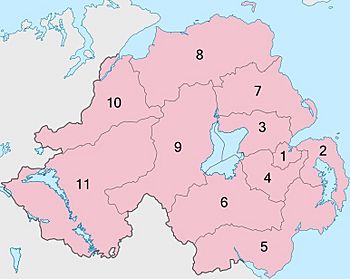Reform of local government in Northern Ireland facts for kids
The way local government works in Northern Ireland changed a lot when 26 local areas, called "districts," were replaced by a smaller number of "super districts." This big change started being planned in 2002. At first, people suggested having either seven or eleven new districts. The whole process was paused in 2010.
Then, on March 12, 2012, the Northern Ireland Executive (which is like the government for Northern Ireland) announced its plan. They decided to reduce the number of local councils to 11. The first elections for these new councils happened on May 22, 2014.
Contents
Why Change Local Government?
Before the big change, Northern Ireland had 26 districts. Each district had its own council, which is a group of people elected to make decisions for that area. These districts were created in 1973.
Compared to similar local councils in England, the districts in Northern Ireland were quite small. On average, each district had about 65,000 people living in it.
In June 2002, the Northern Ireland Executive started something called the "Review of Public Administration." This review looked at how public services were managed and delivered. One of its main suggestions was to reduce the number of districts. The idea was that fewer, larger districts might work better and be more efficient.
First Idea: Seven Districts
On November 22, 2005, Peter Hain, who was the Secretary of State for Northern Ireland at the time, announced a plan. He suggested reducing the number of councils to just seven.
These new, larger councils would have more responsibilities. They would take over tasks like planning new buildings, managing local roads, and helping communities grow. These jobs were previously handled by other groups. The plan also aimed to stop people from being both a local councillor and a Member of the Northern Ireland Assembly (MLA) at the same time.
Many political parties in Northern Ireland, except for Sinn Féin, did not like this idea. They worried that having fewer councils would mean people had less say in local decisions. They also feared that the new areas might be drawn based on religious or political groups.
A special commissioner, Dick Mackenzie, was appointed in 2006. His job was to suggest the boundaries and names for these seven new districts. He shared his first ideas on November 7, 2006. After people gave their opinions, he made some small changes and published his revised ideas on March 30, 2007.
Second Idea: Eleven Districts
In June 2007, after the Northern Ireland government started working together again, it became clear that the plan for seven "super-councils" might change. In July 2007, Arlene Foster, who was the Minister for the Environment, announced a new review.
On March 13, 2008, the government agreed on a new proposal. This time, they decided to create 11 new councils instead of 7. Two ministers from the Ulster Unionist Party voted against this, as they wanted 15 councils, but the plan passed.
The areas for these 11 proposed councils were made by combining the existing districts. For example, Derry and Strabane would join to form one new district.
On April 25, 2008, Shaun Woodward, the Secretary of State for Northern Ireland, announced that the local council elections planned for 2009 would be delayed. They would wait until the 11 new councils were ready in 2011. The names for the new districts were announced in September 2008, with some changes suggested in February 2009.
A new law, called the Local Government (Boundaries) Act (Northern Ireland) 2008, was passed. This law made it possible to create the 11 new District Councils. It also replaced an older law from 1971 that had set up the 26 districts used from 1973 to 2015.
When the Plan Was Paused
In May 2010, it looked like the process of creating the new councils would be delayed. This was because members of the Northern Ireland Executive could not agree on the exact boundaries for the new voting areas within the districts.
A main disagreement was whether the area of Dunmurry should be part of Belfast city or the Lisburn City and Castlereagh District. Edwin Poots, the Environment Minister, did not want Belfast to expand, but Sinn Féin members of the government did.
Because of these disagreements, the proposed reforms were officially stopped on June 15, 2010. Ministers from some parties voted for the reforms, while others voted against or did not vote. As a result, the local elections in 2011 were held for the existing 26 councils, not the new 11.
The head of the Northern Ireland Local Government Association was very upset by this decision. They said it was "clearly not acceptable" that the reform was completely stopped, not just delayed.
New Plan for 2011–2015
After the 2011 elections, the new government in Northern Ireland created a plan for its four-year term. This plan was published on March 12, 2012.
One of the main goals in this plan was to "Establish the new 11 council model for Local Government by 2015." This task was given to the Department of the Environment.
The plan set out key steps to make this happen:
- 2012/13: Pass new laws, including the Local Government Reorganisation Act, to manage the changes.
- 2013/14: Set up arrangements for the "shadow councils." These would be like practice councils for the new districts.
- 2014/15: Get everything ready for the new councils to officially take over their powers.
A draft plan for the new boundaries was published in 2012. It suggested 11 districts with names and borders very similar to the previous proposal. On June 12, 2012, the Northern Ireland Assembly approved this plan. Most parties voted for it, while some voted against. The final order making these changes official was signed on November 30, 2012.






